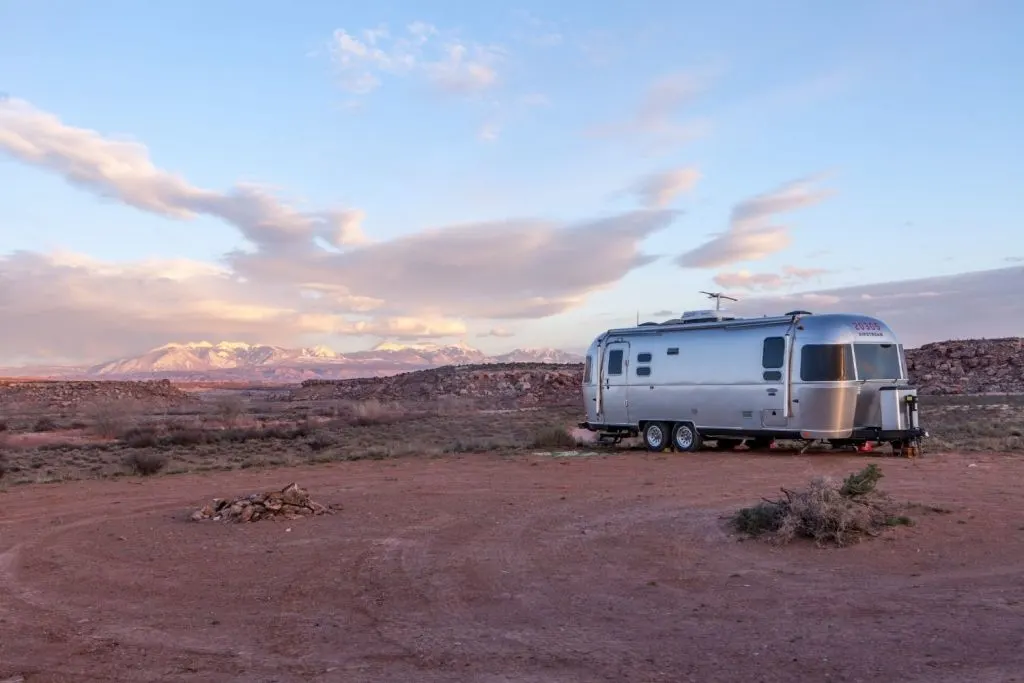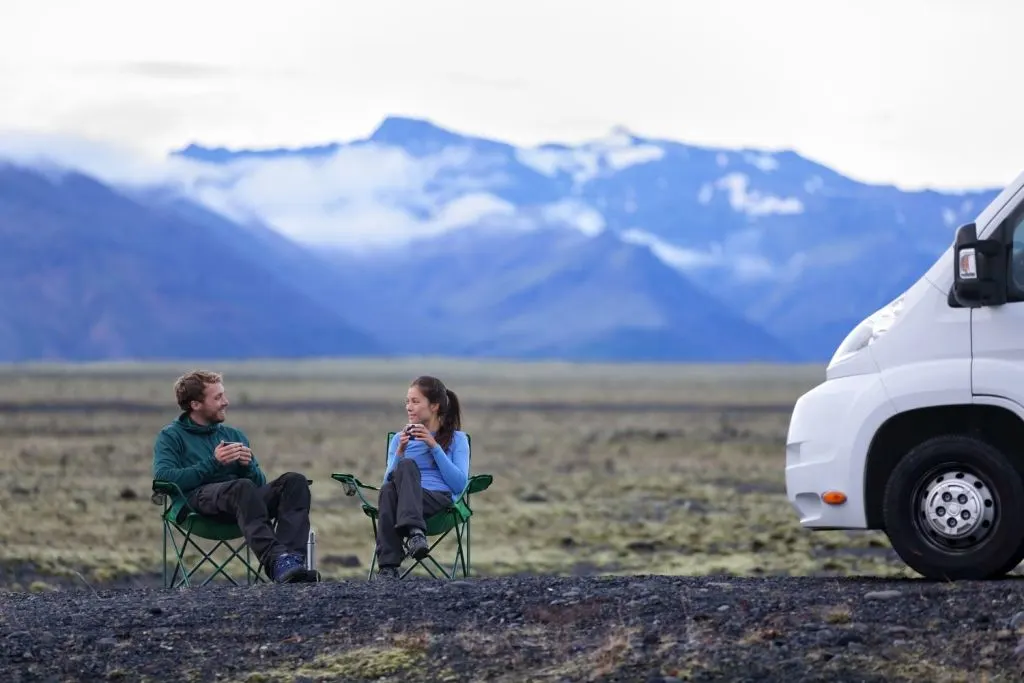What Is Dispersed Camping?
When you are in the camping world, “dispersed camping” as a concept will come up eventually.
What does this mean? Typically dispersed camping means boondocking on wilderness lands in very remote areas, outside of standard campsites.
Types of RV Camping
RV Parks. These are your standard campgrounds, private or public. They have designated spaces, hookups, and bathrooms, Some RV Parks even have stores, pools, pavement, hosts, and other amenities. These parks often have multiple staff members keeping things organized and cleaned.
Campgrounds including State and National Parks. These are your public spaces. The prices are usually lower, and there are some amenities. Some have water and electric, some have dump stations, and some even have lakes, shower facilities, and more. The amenities depend on the location. There are rules and staff, but typically there aren’t any fancy amenities like swimming pools or stores.
Boondocking on public and private land. This is dry camping with no hookups. These campsites are usually on remote government or privately owned lands.

What Is Dispersed Camping?
What does dispersed camping mean? This means that you just pick a spot and camp. Campers are “dispersed” – meaning campsites are not right next to each other.
The point of dispersed camping is to spread out and not crowd your neighbor. This way, everyone can enjoy nature and solitude!
With dispersed camping, there aren’t dedicated ‘campsites’. Sometimes, due to popularity and repeat usage, there are remnants of previous campsites that you can use for your own. These remnants typically include a rock fire ring and a cleared out area.
How to Prepare for Dispersed Camping
To disperse camp, you will need to be able to boondock or be off-grid. For electricity, a solar system or generator can run your appliances and electronics.
You’re going to need to use propane or a campfire to cook. If you’re camping in the West, be prepared and aware of local fire bans!
You’ll need a way to carry enough water for everyone in your party as well as to clean up. Also, you should have a way to deal with human waste. This can be done either with porta-potties or your RV’s black tank.
You will pack everything in and pack everything out including your gray (shower and dishwashing) water. Before heading out, try to make sure that your rig has high enough clearance and is small enough to fit into roads and camping spots.

Where Is Dispersed Camping Allowed?
BLM Land (Bureau of Land Management) usually allows for dispersed camping in most areas, but you want to check on length of stays or any off-limits areas which can change daily during fire or rain seasons.
National Forest Land is a good place to look for dispersed camping. Again, check regulations on specific areas.
Wildlife Management Areas sometimes allow for dispersed camping, but be sure to check all rules for where you can camp and if you’re bringing dogs, some of these areas do not allow them.
National Grasslands sometimes allow for boondock camping as well!
Some Trailheads allow for short term dispersed camping so that you can get a head start on your hiking adventures, but these sites are usually very short term and limited.

Dispersed Camping Near Me
There are a few great ways to find dispersed camping near your location. You can search the web, connect with like minded folks, and do a little basic research. Most of these dispersed camping spots are in the Western US where the large expanses of government land are located.
Look up land maps for public lands in the area you want to travel to. Many times, BLM, National Forests, Wildlife Management Areas, and National Grassland maps will show areas and roads where dispersed camping is allowed.
If you have trouble reading or deciphering the maps, give the local ranger station a call. Ranger stations are familiar with dispersed campers and will be able to give you the best locations, and even directions.
Another way to find dispersed camping is to utilize websites like:
- Freecampsites.net
- Allstays
- Campendium
And so many more! Facebook groups are another great resource for finding dispersed camping near you.
How to Find the Best Dispersed Campsites
Using the methods above like land maps, contacting the local rangers office, using social media, and camping website will all help you find dispersed camping.
So, how do you find the best ones? Don’t settle for the first campsite you find!
Read reviews and find out which campsites have the best views, are the closest to town, has the best cell signal, or is the most easily accessible… Whatever you’re looking for in a campsite, you can find it! And reading reviews is the way to do it.
We cover the best free campsites in the USA both here on our website and on our YouTube channel. There are endless resources to find the best campsites!
Tips for Dispersed Camping:
Always follow leave no trace guidelines.
The point of these free and wild camping experiences is to live close to nature. Just like you appreciate a clean and natural spot, the next person will too.
More and more campers mean more and more opportunities for trash and environmental damange. Leave everything better than you found it! That means pack everything in and EVERYTHING out, including your human waste and gray water – waste water can pollute the plants and local water sources.
Make sure you have everything you need.
You are going to be in the wilderness, you can’t just run down to Walmart if you forget something.
Prepare for inclement weather, first aid needs, food items, and have plenty of fuel for your generator or propane systems. Test systems before you leave, and have tools for just in case.
Having backup plans is a good idea. And, you may not have cell phone signal, so bring paper maps (or screen shots). Let someone at home know where you are going and for how long.
Only camp in areas where it is allowed.
Not all areas are open for dispersed camping. Some areas are ecologically sensitive, wildlife habitats, too close to water, or just generally not conducive to camping. Boundaries of public and private land are often blurred as well so be sure before you camp that you aren’t on private land.
Leave the campsite better than you found it.
Public lands are a treasure, and private ones that allow campers are rare. Keeping things tidy and clean. Not abusing the privilege of camping, and treating the land with respect, will keep dispersed and wild camping options open for the future.

Dispersed camping can be the best way to get back to nature, get away from it all, and enjoy the best nature has to offer in the wilderness. Testing yourself and your camping systems can only be experienced away from hookups and creature comforts. Be prepared for anything and enjoy the great outdoors in dispersed camping locations!
Discover the Best Free Camping Across the USA
To be honest with you, we hate paying for camping. There are so many free campsites in America (with complete privacy).
You should give it a try!
As a matter of fact, these free campsites are yours. Every time you pay federal taxes, you’re contributing to these lands.
Become a FREE CAMPING INSIDER and join the 100,000 campers who love to score the best site!
We’ll send you the 50 Best Free Campsites in the USA (one per state). Access the list by submitting your email below:
My wife and I want to thank you for your time spent sharing so much information. It is great for beginners. We have a 1984 fiber stream and I have literally gutted it out entirely and have started rebuilding it from scratch. To date it is approximately 70 percent complete. We took it out on a test run this weekend at a nearby rv park.
Thank you for emphasizing camping time limits and protection of natural resources on precious public lands.